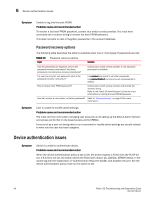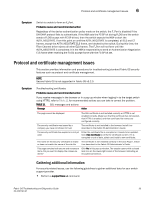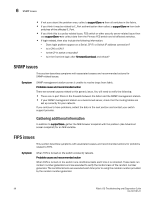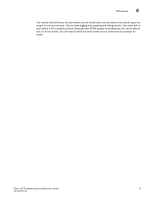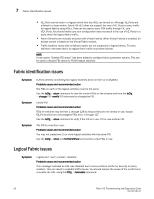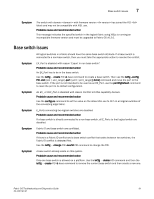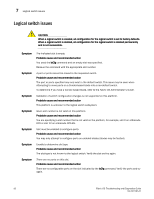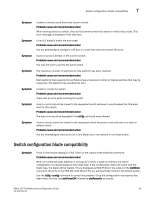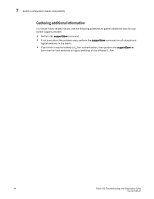HP Brocade 8/12c Brocade Fabric OS Troubleshooting and Diagnostics Guide v6.2. - Page 75
Virtual Fabrics, In this General Virtual Fabric troubleshooting
 |
View all HP Brocade 8/12c manuals
Add to My Manuals
Save this manual to your list of manuals |
Page 75 highlights
Virtual Fabrics Chapter 7 In this chapter •General Virtual Fabric troubleshooting 59 •Fabric identification issues 60 •Logical Fabric issues 60 •Base switch issues 61 •Logical switch issues 62 •Switch configuration blade compatibility 63 General Virtual Fabric troubleshooting All of the following constraints apply when the Virtual Fabric feature is enabled: • The base fabric works only in Brocade native mode, not in an interoperable mode. • The base switch does not have any devices. The base fabric can have devices in remote layer two switches; traffic between those devices is supported. • A non-base switch in a Virtual Fabric-capable chassis must not be part of a fabric that serves as a base fabric for some other logical fabric traffic. Although software will not detect or prevent users from deploying such a configuration, such a configuration is not supported. • ICL ports can only be in the base or default switch. If XISL is turned off, you can connect ICLs to other logical switches. • A default switch can be configured as a base switch in the Brocade 5100 and 5300 switches, but not in a Brocade DCX or DCX-4S. Fabric IDs of default switches cannot be manually changed. • The default switch is able to participate in a logical fabric using extended ISLs (XISLs). In the Brocade DCX and DCX-4S, the default switch will not participate in a logical fabric and will be a purely layer two logical switch. • EX_ and VEX_Ports are supported in the base switch. EX_Ports cannot be part of any other switch other than the base switch. • EX_ and VEX_Ports cannot connect to a fabric that has a logical switch with the Allow XISL use mode on. The port will be disabled with the reason Conflict: EX-XISL capability domain. • Fabric OS v6.2.0 supports external device sharing only through EX_Ports. Internal device sharing (sharing a device in a logical fabric with other fabrics, without having an EX_Port) is not supported. • A logical fabric cannot have EX_Ports using extended ISLs and cannot serve as a backbone to any EX_Port traffic. Similarly, the default switch cannot be part of a fabric that serves as a backbone to any EX_Port traffic. Fabric OS Troubleshooting and Diagnostics Guide 59 53-1001187-01



